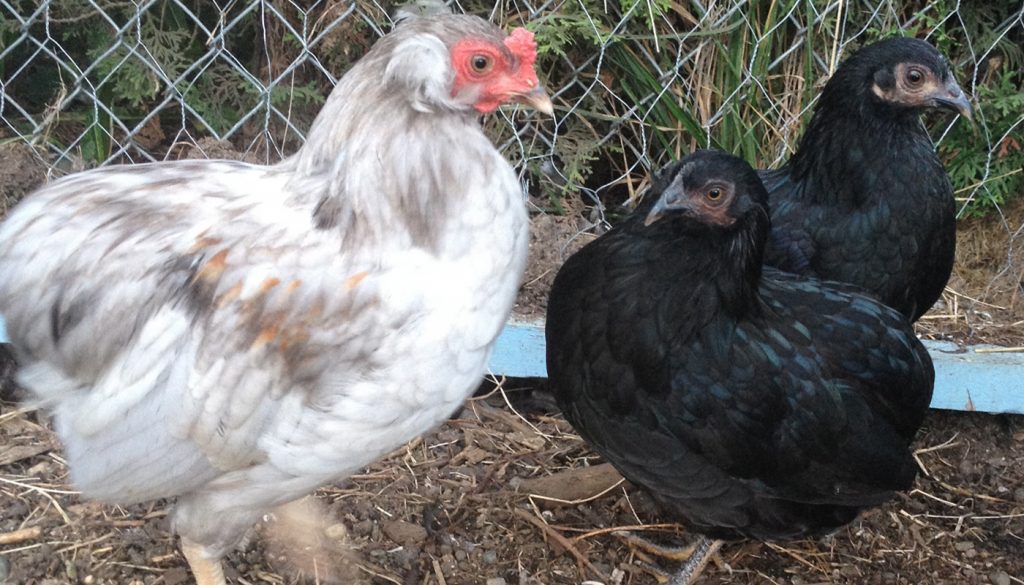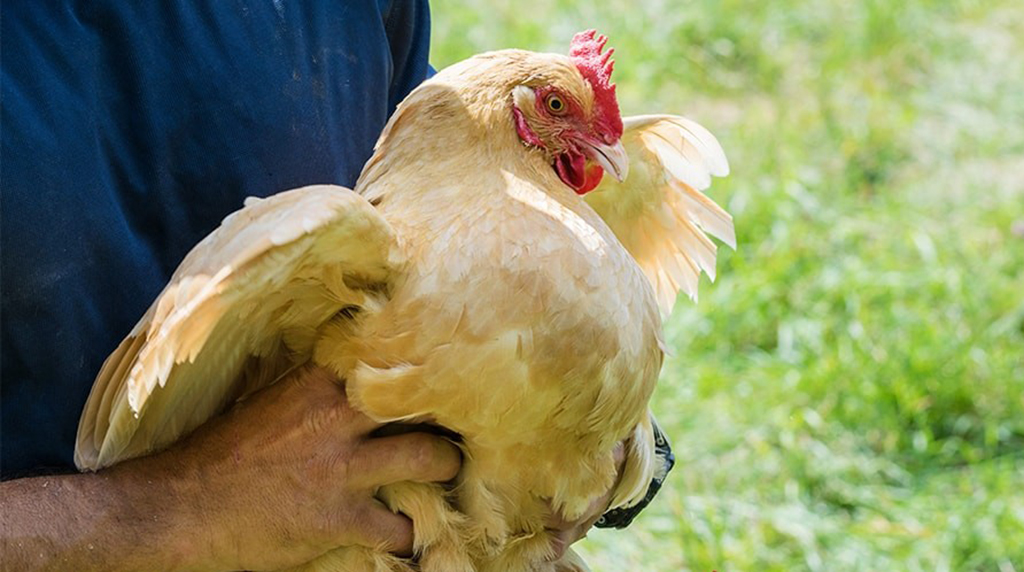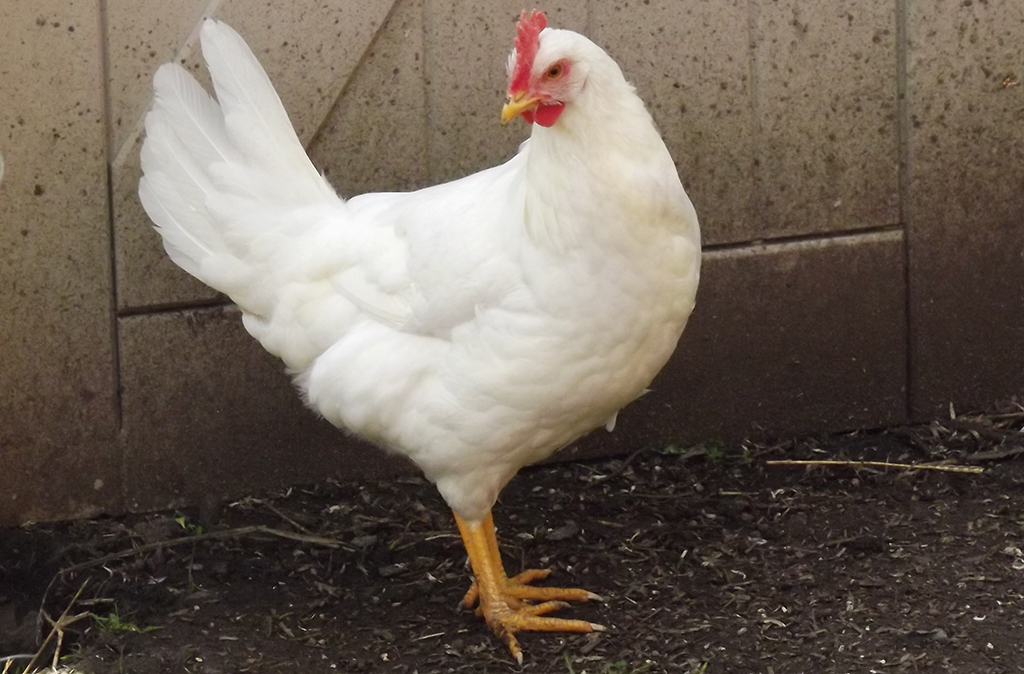
The Araucana is called the South American Rumpless in the USA. They are a very rare breed and have tufts of feathers that extend from the side of their faces which is sometimes referred to as the beard. Only the South American Araucana are rumpless with these unique tufts the breeds found in Europe have beards, muffs and are tailed.
Both the South American and European varieties are best known for laying blue eggs. These eggs have been said to be lower in cholesterol allegedly making them a lot healthier than other eggs. Although there is no supporting evidence of this.
These are really friendly birds that are quite happy to get up close and personal with both their humans and other domestic pets such as small dogs.
The chicks tend to be fast growers that are strong and mature rapidly.
HISTORY
The Araucana or Gallina Mapuche in Spanish is a chicken breed that has its origins in Chile. The Araucana is believed to have come from the Araucania region of Chile hence the chicken’s name.
The standard for this breed is different in various countries in the States it is known as the South American Rumpless and displays ear tufts and will have no tail feathers. The trait of having no tail feather and the tufts are caused by a lethal gene as well as having the rare blue gene trait that is responsible for their blue eggs.
There is not much documented about the Araucana early history. In 1914 Spanish aviculturist Salvador Castello was responsible for naming them “Gallina Araucana”. Named as such for these chickens were mostly found among the Mapuche people who lived in the Araucania region.
Salvador Castello mistakenly reported the Araucana’s as a new species in his reports to the First World’s Poultry Congress in 1921. The name Gallus inauris was to be their proposed name. It was not until quite a few years later that research found that the Araucana was not a new species and in fact belonged to the same species as the domestic chicken (Gallus gallus domesticus).
There are many theories about the bird’s blue egg gene and what causes the genetic mutation.
Breeds that have been bred from the Araucana such as the Ameraucana and the Easter Egger also carry the blue-egg gene.
The Araucana was standardized by the American Poultry Association in 1976.
CHARACTERISTICS |
|
|---|---|
| Country of Origin: | Chile |
| American Poultry Association: | Recognized as a breed of chicken in the United States |
| Chicken Category: | Standard Breed |
| Chicken Class: | Miscellaneous |
| Bantam Variety Available? | Yes |
| Related | TOP 10 BANTAM CHICKEN BREEDS FOR BEGINNERS |
IDENTIFICATION⇒ |
Appearance: Araucana is quite round short bird that do es not have tails and tends to have quite an upright stance. Their broad skulls have an unusual feature on either side of their heads. It looks like a wart and is positioned where you would usually find an earlobe. This is called the plicae (a fold or ridge of tissue) which has feathers that extend from them that seem to swoop backwards and look like tufts or a beard. They have a very small pea comb and no wattles.
Color(s): Both hens and roosters are recognized in five different colors:
White, black, black breasted red, golden duckwing and silver duckwing.
Comb: They have a small pea comb
Ave. Weight: Hens/Pullet 4.8 to 5.9 lbs.
Cockerel 5.9 to 7.1 lbs. |
| Life Expectancy: | The average lifespan is 6 – 8 years depending on the chicken’s environment some have been known to live longer. |
| Good Starter Chicken? | They are a sweet bird but are rare in the USA but are a low maintenance bird that would do well in any flock. |
| Related | 10 BEST STARTER CHICKENS FOR THE FIRST TIME POULTRY KEEPER |
PURPOSE⇒ |
Eggs: They are average egg layers.
They lay medium sized blue eggs up to 160 per year The eggs tend to drop off in the winter as they do not like the cold. They start to lay eggs from around 5 to 6 months old.
Meat: They have white meat and make an excellent table bird.
Breeding: The hens tend to go broody and they make excellent mothers. Breeding these birds can be quite a challenge due to their lethal gene.
If you are looking to breed Araucana it is advisable to learn about the process from an established breeder or the Araucana Club of America. For advice on breeding please check our guide to breed poultry.
Foraging: Fresh grass is a must for these birds who love to forage about in it.
Show Bird: Araucana are mostly kept and bred to be show birds.
Pets: A great pet as they are friendly and docile.
Other: They need a lot of fresh patches to forage and scratch about in, so it is best to keep in different areas of the garden and move them around every so often.
They will give your organic garden a lot of nutritious fertilizer to ensure great blooms and tasty vegetables. |
| Health: | They are hardy birds with not many health issues |
| You may Also Like: | HOW TO TELL IS A CHICKEN IS SICK |
| Temperament: | A docile friendly mothering bird that will brighten up your flock. |
| Flyers? | They can be flighty if spooked otherwise they are a very placid bird. |
| Noisy Birds? | They can get loud but are mostly calm docile chickens. |
| Interaction with other chickens: | These birds make a great addition to any flock especially if you are breeding chickens as they are broody and will sit on eggs. They are also good mothers and generally socialize well with different breed due to their sweet natures. |
| Good with kids? | They are good with kids and will try to mother them too. |
| Related | 10 ROOSTER BREEDS THAT DO NOT MIND CHILDREN |
| Socialize Behavior? | Araucana do not mind chatting and mixing with other domestic animals. |
| You may Also Like: | HOW TO SOCIALIZING YOUR NEW CHICKENS |
| Known predators: | Most domestic animals leave them alone, but it is always best to keep an eye on dogs and cats. If hawks and or foxes are in your area it is always best to take precautions. Check with local animal shelters, zoos, vets, animal control and or pet stores about common predators in your area. |
| Conservation Status: | Although they are rare in America and usually only found at a breeder they are not listed in the poultry conservation. To check on a birds conservation status go to the Poultry conservation website or national conservation centers. |
IDEAL ENVIRONMENT⇒ |
Garden Size: Araucana do not mind being penned but they do require quite a bit of space to forage around in. A medium to a large garden is more suitable for this breed.
Ideal Climate: They do a lot better in the summer as they are not too partial to the cold. They will need a little extra insulation in the coop during the colder months, especially in the extreme cold weather.
Ideal Coop: The rule of thumb for any coop is 50 cm x 50 cm per hen/rooster in the coop.
Ensure there is a good space for the nesting boxes and nightly roosting rails at least 1.5 inches wide. Good ventilation for air but not too drafty especially in winter. It is always a good idea to raise the coop off the ground to give the birds a dry place to roost and lay especially in wet weather.
Ideal Coop Run: Araucana are not fussed about flying and will if they need to. The run should be completely covered to protect your birds and ensure that they do not fly the coop.
Ideal Flock Size: It is best to have more than one bird in your flock. Most chickens love to socialize and do better when they have company to forage and roam about with.
Special Instructions: Unless they are being used to breed with they are a low maintenance bird that does not have any special requirements.
Accessories: The following accessories are ideal for your coop:
Nesting boxes Straw for the boxes and roosting area Roosting rails Perches Water troughs/bowls Food bowls/feeders Heating lamp(s) Animal carrier for transport purposes |
| You may Also Like: | 45 FREE DIY CHICKEN COOP PLANS, TUTORIALS AND DESIGNS |
WHERE TO FIND THESE BIRDS TO ADD TO YOUR FLOCK
As these birds are quite rare in the United States you will not find them at poultry outlets and farms. If you do find birds that may be marked as Araucana at a local live poultry outlet or online retailer it is best to check the bird. There are times when dealers mistakenly name Easter Egger chickens as Araucana or Ameraucana chickens.
Araucana is mostly found at registered breeders of which you can find on the Araucana Club of America website or local animal welfare, vet, etc.
CARING FOR THE BIRD(S)
Please click here for our full guide to “Taking care of chickens”. This is a comprehensive guide to owning chickens. It covers where to start from choosing your ideal flock, the coop that would best suit your garden, your bird and you to buying and bringing your bird(s) home.
GENERAL
Araucana is a sweet and unusual bird that will add personality to any flock. They are the greatest mothers and will gladly step in to help out another chicken mother. Brooding another chicken’s eggs is another task this gentle bird does not mind taking up.
GROOMING
If you are keeping Araucana for show birds it is best to check on the what the standards are for the shows. Other than that, they do not need any special grooming other than the regular weekly checks for mites, lice and various other parasites. Speak to the breeder you purchase your Araucana from for advice on de-worming your birds, your local vet should also be able to help with this. As these birds love to forage about and seek out new scratching patches it is imperative they are kept pest free.
DIET AND NUTRITION
Every morning before letting the Araucana’s out to free range make sure they have a hearty breakfast of either grain, chicken pellets, chicken mash or grain mix. For chickens under the age of 8 weeks old, they should get a meal like Chick Starter.
These beautiful birds love to receive hearty table scraps and will eat most vegetable or fruit leftovers.
If they are laying hens, ensure they are getting extra protein and calcium in their diets to ensure the quality of their eggs and to keep them in tip-top health.
Please see our comprehensive guide to “Feeding your chickens” for more information of the different types of chicken feed for chicks, hens, laying hens, roosters, etc. and where to buy the feed and approximate cost of the feed.
SOCIALIZING THE BIRD(S)
These social ladies will take to most any other chicken breed that joins their flock. As with any flock, there is a pecking order and even the most docile birds tend to get crabby if it is not adhered to.
Always check on how well a breed will get on with your current flock before buying them as you do not want to upset your coop or stress your current flock.
As with any newcomer to the roost, you will have to quarantine the bird for 7 – 31 days to ensure it does not have any unwanted critters or disease that could spread to your current flock.
NOTES / SPECIAL INSTRUCTIONS
As they are not registered with any critical conservation status but check with the breeding clubs for any special license you may need as they are a rare breed in the USA. For advice on what the bird’s conservation status and orders are please check with your local conservation department.
For breeders, it is imperative that you always check your bird’s bloodlines and ensure you are buying your birds from a reputed breeder/farm. In order to sell birds of such stature, they have to be recorded and documented, always check with local animal breeding organizations for these records.
These legitimate documents are also required should you wish to show your bird(s) in various poultry shows/competition showings.
For information and advice on adopting rescued animals, you can visit or contact your local animal welfare center.
Video
USEFUL LINKS
- Caring for your Chicken
- Feeding
- Health
- Socializing your Chicken
- Breeding Chicken
- Raising Chickens A-Z
- Hatching Eggs
- What is Molting
- Animal Shelter (ASPCA)
- American Veterinary Medical Association
- American Poultry Association
- American Animal Welfare Society
- American Animal Control
- American Animal Husbandry Society
References
- https://en.wikipedia.org
- https://livestockconservancy.org
- https://www.roysfarm.com
- https://www.mypetchicken.com
- https://www.backyardchickens.com
- https://www.feathersite.com/
 45 FREE DIY CHICKEN COOP PLANS, TUTORIALS AND DESIGNS
45 FREE DIY CHICKEN COOP PLANS, TUTORIALS AND DESIGNS 10 Chicken Breeds for the Colder Climates
10 Chicken Breeds for the Colder Climates Cockerels and Roosters
Cockerels and Roosters Rhode Island Red Chicken Breed – Everything You Need to Know
Rhode Island Red Chicken Breed – Everything You Need to Know 10 Beautiful Black and White Feathered Chicken Breeds
10 Beautiful Black and White Feathered Chicken Breeds Why Deworming Chickens is Important?
Why Deworming Chickens is Important? 10 Chicken Breeds for the Hot Climates
10 Chicken Breeds for the Hot Climates 10 Best Tractor Coop and Runs to Buy
10 Best Tractor Coop and Runs to Buy Top Chicken Breeds for Free Ranging
Top Chicken Breeds for Free Ranging Understanding Chicken Stress: Causes and Solutions | Tips for Happy Flocks
Understanding Chicken Stress: Causes and Solutions | Tips for Happy Flocks Chicken Breeds that Lay Brown, Blue, Green, Olive, Pink or Different Colors
Chicken Breeds that Lay Brown, Blue, Green, Olive, Pink or Different Colors Top 10 Bantam Chicken Breeds for Beginners
Top 10 Bantam Chicken Breeds for Beginners